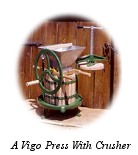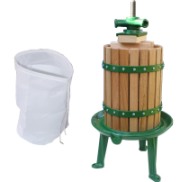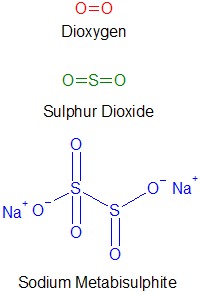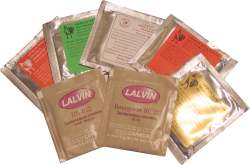
Bob
The Brewer
|
Hello, As you may know by now I'm bob and today I'm going to tell you how to make wine from scratch. Not just any wine, a good genuine grape wine.
|
First thing we have to do is find the right grapes for the wine. Most people will be limited to grapes they have been given, have growing, or have bought. You can nearly always make 'some' kind of wine from any grape, but good grapes make the best wine. If you are about to plant a vine to grow grapes then it is really worth looking at the available types to find the one that will suit.
If you have control over when the grapes are picked aim for dry day when the grapes are ripe, never under estimate the power of a few more good days on the vine to ripen your grapes. If you want to measure the sugar content hence ripeness of the grapes you can use- a hydrometer
- a refractometer
The second is a rather expensive piece of kit but only requires a drop of juice rather than a sample jar full.(remember that if testing the average ripens of your crop you must randomly select grapes for a representative picture) |

|

|
Once you have the grapes you plan to use you will need to get the juice out of them. This is harder than it sounds. The first step in juice extraction is to 'crush' the grapes or brake the skin. For small crops this can be done by hand or an electric juicer (which also skips step two), for somewhat lager crops you can use a large bucket and 'tread' your feet or Vigo's Pulpmaster, for large crops a proper grape-mill becomes essential. |
|
Once the skins are broken you can 'press' the juice out of them. (If you are making a red wine you may want to ferment 'on the must', this aids colour and tannin extraction, to do this you only press the grape pulp after 1-3 days of fermentation) Again depending on how many grapes you have you can place the grape pulp in a a nylon straining bag and wring the juice in to a bucket(dont put too many grapes in the bag or net at one time), or for larger amounts you can use a purpose built press. |
 Straining Bags
Straining Bags
Presses & Crushers |

|
Now you have your juice you must protect it, firstly; and hopefully obviously from flies (fruit and any others) that will ruin the juice and wine very quickly. The second; is from oxygen and spoilage organisms. Oxygen or O2 is a gas that makes up about 20% of the air around us, It does many things including letting us breath, metals rust, and important to us, oxidizes wine and fruit juice leading to the formation of acetaldehydes and acetic acid (vinegar). This must be avoided at all costs. One may use sulphur dioxide which prevents the O2 from affecting the wine, it also kills wild yeasts and other bacteria that may be in the juice. The correct dose is about 120mg per litre, or 1g of sodium metabisulphite per gallon. This can be weighed out using an accurate balance or you can use 2 crushed campden tablets. (1 campden tablet contains 0.5g of sodium metabisulphite) |
|
Now we need to add a good wine yeast to the must. There is a great range of yeasts availble, the most easily obtained and kept are the dried yeasts. Gervin is such a yeast and an appropriate type for the wine can normally be found in their range. |

Gervin yeasts
Lalvin yeasts
|
When you have added your yeast you can sit back and wait for the fermentaion to be completed, you can ferment in glass demijohns, carboys or food grade plastic containers. You should aim to start the fermentaion at a temperature of about 18°C-21°C possibly as little higher but not much, once you can see evidence that the yeast has taken hold the temperature can be lowered to around 13°C-16°C. Generally red wines can be fermeted a bit warmer than white. Wines like 'Cabernet Sauvignon' can ferment for a while as hot as 23°C-25°C though this is not the normal rule. If the temperatue is too warm the taste and bouquet will be spoiled.
The fermentation should take about three weeks, and then can be left for up to six weeks to stand. The wine should be racked of the sediment before the end of that time to prevent the wine from picking up a mousey taste from the dead yeast cells of the sediment. |
|
|
|
Once the wine has been racked off the sediment into a clean container it should be stabilized. Finnings can then be added to speed clearing. Once the wine is clear it can be bottled.
Much more information on making wine from grapes can be found in Growing Vines to Make Wines by Nick Poulter, which is an excellent guide to both growing grapes and making wine from them. |
|
Back to TopWWW.STONEHELM.CO.UK
-------------------------------------------------------------------------
© 2004 - 2011 Stonehelm. All rights reserved